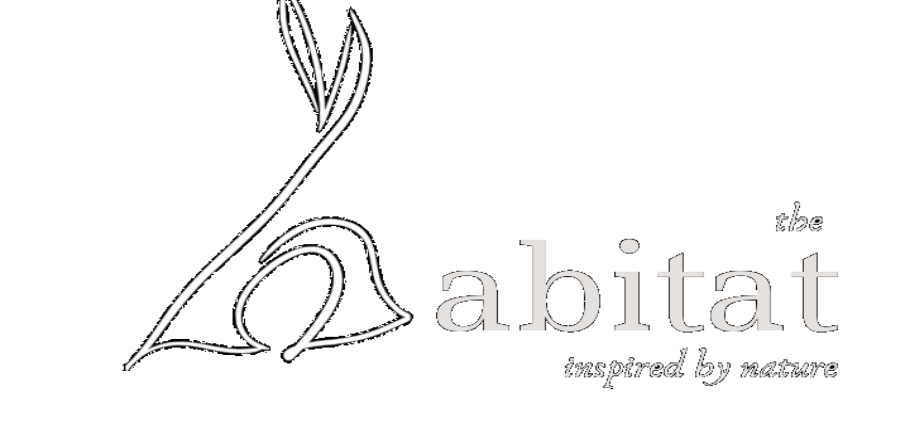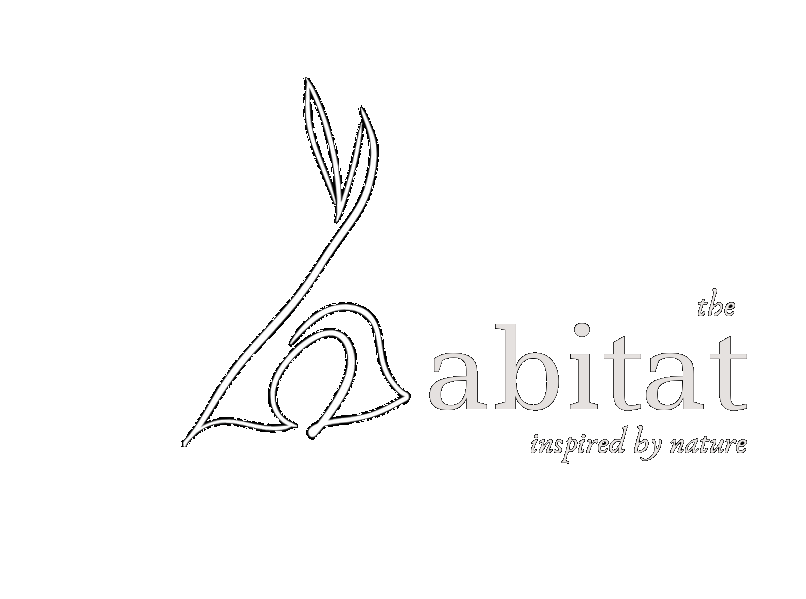more diversity
Permaculture
Garden
Harmony between
humans, animals and plants
Biodiversity
is the key
Where Permaculture comes from
“As permaculture (from the term “permanent (agri) culture” derived suitcase word; “permanent agriculture” or “permanent culture”) is originally a sustainable concept for agriculture and horticulture, which is based on natural ecosystems and cycles in nature observe and imitate. The concept was designed by the Australian Bill Mollison together with his student David Holmgren in the 1970s. In 1981 he received the Right Livelihood Award for his work. Permaculture has developed from an agricultural design method to an ecological philosophy of life and a global grassroots movement. Holmgren now describes permaculture as a culture of sustainable living and land use. In Europe, permaculture is practiced in private house gardens as well as on medium-sized farms.” (source:wikipedia)

definition
Permaculture
This is a form of the holistic design of nature-living spaces that are used and respected equally by humans, animals and plants. It is a very old and successful way of managing natural resources. One goal is to have as little (especially fossil) energy as possible and as little intervention as possible in the gardens. That is achieved, for example, through planned combinations of different plants that support each other and the selection of the right location. By creating height differences and using the natural topography of the country, the natural flow of water and gravity can be used in the best possible way. Small water basins or biotopes store the precious well.
Integrated into a foodforest, a tree is used to provide shade for more sun-sensitive plants, or a hedge is used as a wind protection measure. The planning of the garden is important before the implementation and such combinations should be considered.
DIFFICULT TO DESCRIBE BUT
easy to understand
In principle, permaculture is easy to understand if you see it with your eyes and feel it with your heart, but difficult to describe in words. It is based on the forest ecosystem in whichtheire all all kind of Plant. That means you have tall trees and different plants asswell many, that grow underground, they promote and support each other. A large amount of plant material is produced in a garden every day – without the need for external fertilization and energy. This material is, for example, fallen leaves. These provide habitats for small animals and insects and are converted into fertile soil by them and microorganisms. A food forest is a closed ecosystem. Permaculture is based on this model and thereby creates “edible ecosystems”. It can be on a small scale in the home garden or on a large scale as a food forest.

Inspired by Nature
diversity is
the key

MORE THAN
Organic
An important principle is a large mix of different plants and a balanced variety. In contrast to a monoculture garden, where different fertilizers and pesticides are used to ensure unhindered growth, the focus in permaculture is holistic. That means, that many plants and a natural small-scale crop rotation do not “suck up” the soil. Additonal to that the chickens move freely in the garden and thereby loosen the soil and eat instects, do not let them take out of hand.
They also fertilize the soil and add important nutrients to it. It depends less on the multitude of individual species than on the multitude of useful connections that exist between plants and animals. A permaculture garden is therefore a network of beneficial connections, where as much as possible regulates, regenerates and supports itself and the gardener has to make as little effort as possible.
The principles
of organic agriculture also apply to permaculture, i.e. the circular economy: The renunciation of synthetic-chemical fertilizers and pesticides. However, permaculture goes a few steps further than organic farming, as this is dependent on e.g. the use of machines and thus on fossil energy. These machines also often damage the susceptible layers of soil and additionally compact it. In addition, monoculture is often used in organic farming, as this increases productivity and also makes harvesting easier. Organic farming cannot meet the permaculture principle of sustainable efficiency either. Permaculture is more than just gardening or farming.
It is something you do by heart and conscience.
There are no standard instructions, it is much more about observing and experimenting.
The Secrets of
Permaculture
<<David Holmgrades>>
12 principles
Work with nature and not against it!
Through constant and careful observation and the creation and support of natural processes, you stimulate your garden to grow and also support you with a well thought-out interplay of various elements of the newly created system.
Since the beginning of the commercial use of agricultural land and is rediscovered. Now we sensibly use energy sources such as water, soil humus, seeds and own compost, witch permaculture has been redefined.
This is an important (survival) natural resource for all cultures. In today’s world with advancing climate change, it is important to reconsider. The natural resources available to us are finite! We have to store them as best as possible and be able to access them when needed without using chemicals. It’s the ongoing devastation, the fallow and starved soils that are covered with monoculture to provide new nutrients and revive life
Local and regional independence is the motto.
Harvesting allowed! And even expected!
Such a garden plant and the maintenance of high-yielding systems inspires more and more people all over the world. Successful permaculture systems will spread. The best way to private and communal self-sufficiency.
With as little work as possible to the greatest possible success!
In permaculture systems, a lot of parts regulates themself – these processes are also called productive feedback loops. It is important to recognize these loops and use them for yourself. The less it is necessary to intervene in an existing healthy system, the lower the likelihood of disrupting this sensitive symbiosis and creating more work due to the consequential damage it causes.
Convert finite energy into infinite energy!
The system can be strengthened and development. Growth can be stimulated and steered in the right direction through the careful but purposeful use and application of renewable resources. Everything has its job. Whether sun, wind, water, insects,
and organic biomass. As the garden ages, attempts are made to forego non-renewable energies such as fossil fuels in cultivation.
No Waste!
All waste that normally occurs is avoided as far as possible, materials are reused as often as possible: refuse, reduce, reuse, repair, recycle is the motto
Observe, take a closer look and learn from nature!
Successful design first requires an understanding of the overarching patterns in nature. The planned details of a permaculture project it takes these naturally occurring patterns into account and are mainly based on them. As an example, top-down thinking, in which the tasks of shade and nitrogen donor form the basis of life for the plants growing underneath. Or gravity is used for irrigation.
This reinforces the bottom-up pattern, which enables the plants to grow and develop under the protection of their larger conspecifics.
In groups instead of singles!
Many different elements that can work together and support each other are more useful than those that largely stand alone and thus compete with each other. Here it is better to fill gaps and save the soil.
Nature takes its time!
In the natural environment, nature develops small and slow solution strategies to ensure survival and to adapt to new circumstances. These systems are also easier to understand for humans and, although less profitable in the short term, they are more productive and healthier in the long term.
Use diversity for yourself and preserve it on the long term! Many different fruits and vegetables increase the reliability. Because in a permaculture garden you have to learn that there are animals that appreciate the fruit as much as you do. A an example, the bird that eats your berries or the mouse that eats its fill on the beetroot. All living things in your garden should live in balance. That is why the rich variety is so important and this in turn enables a long-term self-organization of your garden.
Thinking outside the box!
Many different conditions come together at the transition and edge zones of your garden. That makes them particularly diverse and therefore productive. It is not just because a bed ends, that, that has to be the end. It can also merge seamlessly into the next, and bushes or stones offer a habitat here to accommodate the predators of various pests.
Respond to circumstances and excesses!
Nature is constantly changing. If we forese change, we can use it to benefit us. Because every season creates the right conditions for a whole range of different plants; Every crisis is also an opportunity, because the climatic changes make the cultivation of new exotic cultures possible. That is a new diversity that enables us to respond to.
Process your successes!
When the tomato harvest overwhelms you with the delicious red fruits, cook them for the winter and create a foundation. The lemons provide you the lemonade and the potatoes the energy for your daily challenges with your own little paradise.


First of all
Find the right Zones
The different growth zones in a permaculture garden are called permaculture zones. These zones are best planned before creating such a garden in order to define the amount of maintenance, harvest times and paths actively used on a daily basis. That means, that the more care-intensive plants and beds are created on exactly these paths, as these are often used.
The garden is therefore also divided into different growth zones, depending on how often these are visited during the day or within a week to see, if everything is going well. It is important, that these zones are also divided into maintenance, planting and production areas.
Short ways saves time
The next important thing depend on the fact, how much attention an area needs. That means, that an Area is placed closer to the center or daily used “walkways” or ends up in the outside areas. These planed Permaculture zones save a lot of time and energy by reducing the travel required.
So you can be sure, that the right planning, makes a huge difference in the annual effort of such a large garden.
The planting zones in a permaculture design are numbered and laid out from the inside to the outside. Zone zero forms the center from where everything starts. From here we count outwards into the areas that are not often visited.
This gives the impression that the remaining zones move in a circle around this zero zone.
Depending on the location, the landscape and you use it. However, this shifts as little, as can be seen in the planning of our garden.
It starts in the Center
The planting zones in a permaculture design are numbered and laid out from the inside out. Zone zero forms the center from where everything starts. From here we count outwards into the areas that are not often visited.
This gives the impression that the remaining zones move in a circle around this zero zone. Depending on the location and use, however, this shifts as little, as can be seen in the planning of our garden.
The Zone - Plan
We use two different zone systems
Our property is divided into various large areas. That means, that each “large zone” is divided into individual sectiones. Since we also have different care intensities in different areas, but the daily visits to certain areas take place, it is not divided into circular areas.
Main -
Zones in our Habitat
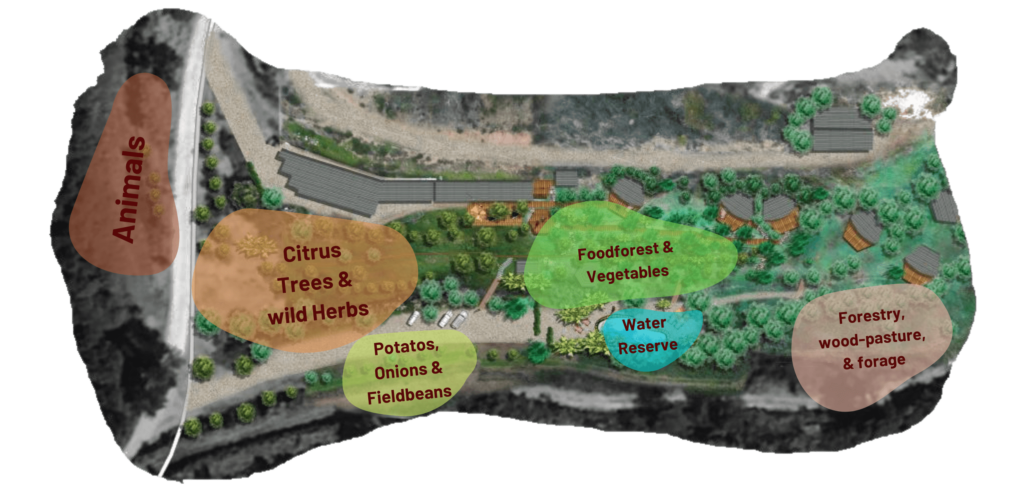
The food forest and vegetable garden with all its zones formed the heart of the HABITAT and is in different zone sequences. Each zone has a use and is strategically and irrigation technology and a good state to save time in the care of the harvest and new sowing.
This central zone is explained in more detail.
This zone contains the old trees. These are predominantly lemons, oranges from Seville, sweet oranges, clementines and mandarins. They were planted a long time ago and require little attention due to their long-term growth. They have to be cut over and over, but are largely self-sufficient.
This zone also serves as a feeding zone for the chickens and Peakhocks. This area is close to theire Home and they enjoy walking in the save roofed Zones in shade of the Trees. That means, that they roam free here the hole day, eating pests, seeds and insects that are at the base of these trees. They also scratch with their claws for tasty treats and keep the tree slices clean and work their own vecals into the soil. That brings fertilizer and energy to the fruits.
Of course we have also opened up new areas in those sections and planted some additional trees, that will give this monoculture a greater diversity in the future. We try to enrich the soil with various green plants as a basis for humus.
Basically, this area is an independently functioning system and does not need to be watered.
Here you are invited to harvest and enjoy.
We refer to this area as our northern slope. It is about 100 meter long and 5 meter wide terrace at the bottom of the mountain. This is protected from sun radiation by old cork oaks. The soil is very nutritious due to the humus layer of the trees and even in midsummer it is moist due to water, which collects there due to gravity. Some small springs supply the plants independently.
This area is further away from the Mainhouse and is mainly cultivated with field vegetables. They only need a little to no attention and can grow in peace. We have chosen vegetable varieties that can grow in the slightly cooler winter and also do not tolerate the heat so well in summer.
For example there we have onions, potatoes, garlic, field beans, quinoa, leek, ginger, radisch, cauliflower, kale, kohlrabi, broccoli and much more. Different apple, quince, cherry and pear tree varieties that prefer somewhat cooler temperatures also find their place here.
Above the garden-zone we have developed a spring that also continuously creates a water reserve and supplies our vegetables in the garden with the necessary water without energy.
This area has the sice of about one hectare and is the place for our animals. We have goats, donkeys and chickens here, and I’m sure there will be more soon.
This area also has old trees and they provide natural food and shade for the animals. Theire is a direct water access to a small stream. That eliminates work, which really adds up over the days.
We have also set up our composting system here. That is filled with the manure of the stables and also green waste and kitchen waste. Since we take the route to the animals every day anyway, to milk the goats, feed the chicken and collect the eggs, thats the reason, why we have choosen that location for composting. From here we bring the finished soil to the vegetable beds in the food forest or the dung to the trees in the garden.
Water and reserves is an important commodity. Especially in times of climate change and the resulting progressive drought, it becomes difficult for areas to get by without irrigation. The streams also get drier and drier in summer and the heavy rainfall in winter seldom.
The soil on our property is partly very depleted due to the lack of maintenance and has little or no humus layer. With the humus layer we reach an important water reservoir.
With only 1% humus content per 1 hectare, 430 cubic meters of water can be stored. When it rains, this layer absorbs up to 150 liters of water per hour and slowly releases it back to the surrounding roots. This reduces flooding in heavy rain and counteracts erosion.
We also plan to create a natural swimming pond to collect and store the water masses that flow through our valley in the winter.
A spring that continuously supplies water even in hot summer is caught and used.
These areas are one of the most important in a permaculture eco-system and keep the wild nature in their own equilibrium and fertilize themselves. They not only provide food and also give us firewood for the winter, rather they also bring an important natural humus layer, which can gradually be dug up and used. The slopes protect themselves from erosion and hold back water and thus feed the areas with water below which we use as fruit plains. We will definitely have to lend a hand here for the next few years to get some of the wilderness under control and to give nature the chance to develop and grow wild-controled.
Foodforest as Center
in Zones and Sections

Discription
We want to explain this area in more detail and describe the zones and sections and explain the reason for this zoning.
Center of activities – the main house. This is the central starting point.
Herbs and perennial chillies as well as tea bushes and herbs for drinks and other plants that need attention.
This area is the center of the Permaculture Garden and is still very maintenance-intensive in the younger years.
This zone forms our extensive vegetable garden.
That is divided into different sectors, which are created according to harvest and care intensity.
These plant sectors do not require daily attention and have a longer or independent “maintenance-free” growth phase. There is no more watering here every day.
Shrubs and old-tree stock with citrus fruits. Very low maintenance and dont have to be watered that often.
Wild zone in which nature is in charge and in which we only harvest what is abundant. This zone will be further expanded and will be included into the Foodforest.

Zone 0
Main Zone
The center of activity in our case is the Main meeting point of all activitys, like for breakfast, Lunch and Dinner. The Reception is also situated in that Area and has the function as arravial point.
That Area forms the outdoor kitchen and the lounge area for our guests and seminar participants. From here, the paths lead through our central platform to a large number of different zones. In this zone, various herbs grow alongside useful plants and many flowers and some shade-giving fruit trees.
Zone 1
The Plateau
forms the starting point to all areas and has a quick access, which requires intensive care for some plants. That means, that theire are growing a selection of mostly used herbs for the Kitchen and different exotic fruits. These require more water and are often used or need special attention.
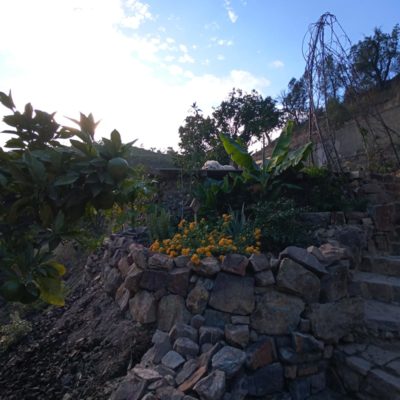
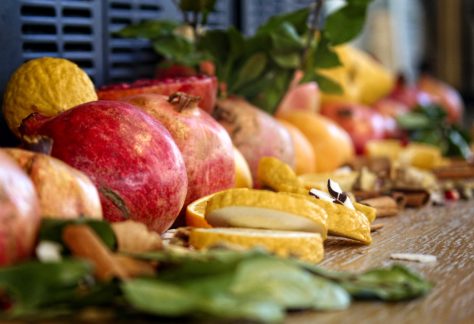
Zone 2
The Foodforest
The food forest contains an independent microclimate as well as annual plants, herbs, compost systems, plant reproduction and maintenance-intensive areas.
This area was newly created. During the growth phase and the variety of plants and different sectors created, it sometimes needs more and sometimes less attention and care. That also forms the center and the paths are used daily by us and our guests.
Zone 3
Main Veggie
Garden
This zone forms our extensive vegetable garden.
This is divided into different sectors, which are created according to harvest and care intensity.
Although this zone is not very close to the center of activity, this area is nevertheless strategically very well located according to permaculture principles. The garden is central and protected in the water and nutrient-rich bed of the slope and is protected from wind and excessive sunlight by trees. Due to the fact that this area is visited daily in order to harvest the necessary food, the attention can also be called to the garden.


Zone 4
walk and pick
The plant sector does not require daily attention and have a longer or independent “maintenance-free” growth phase. Thei´re growing all kinds of plants, it is not necassary to be watered every day. We planted many strawberries, blueberries, hollunder bushes, hibiscus, goji berries, physalis, zucchinis and different pumpkins.
Zone 5
Old
Fruit - Trees
Due to its age, our citrus garden no longer really needs attention. The trees are already firmly rooted and we have the honor to come mainly to harvest and enjoy the area. At the entrance we planted some new fruit bushes that still need a little attention.


Zone 6
Wild Nature
With around 4 hectares, this zone is the largest zone on our property. Along the two streams you will find an unbelievable variety of wild herbs that we use. The forest also provides us with construction wood for our projects and firewood for the winter. In spring and autumn this zone also serves as a food supplier for our animals.
Here nature has the opportunity to develop freely. We will gradually develop some areas further and make the fallow areas fertile again.
permaculture
in practice
SOME
Examples
Many People think directly about the “old outhouse”. But a dry toilet has many advantages and the best is:
When used correctly, they do not smell at all and save huge amounts of water
The ancient Inca tribes have already shown us how we let different plants and vegetables grow together to protect and support each other perfectly
Produce your own active carbon and you create living space, water storage and a huge surface for microorganisms that help your garden to grow


Importent
Water
Management
Water is an important commodity and needs to be collected and stored carefully. In winter there is a rainy season that literally floods the country, but also the dry summer where every drop is important.
We decided to go for the topographical location with a south-facing slope between the mountains in order to be able to use these features for us and to use natural gravity for the water reserves. Our property is criss-crossed with two small streams and a spring on the northern slope. That has also been developed by us. We use these water reserves to irrigate our food forest and equip it for the future so that it develops into a self-sustaining microclimate and in the future stores its water itself and releases it again.
The natural swimming pond is fed by the spring and cleans the water in a natural way with the help of small waterfalls and relaxation areas. We keep this reserve for fire prevention and really strong dry periods.
A CYCLE
Composting
One of the most important issues for healthy soil is the composting of organic matter. We have created several composters for this purpose, which are filled with green waste, animal dung, branches and kitchen waste. We also have dry toilets for our visitors, with which we can produce important nitrogenous fertilizers. The soil is added to the plants and trees as humus and fertilizer and gives nature the strength to grow.

Stop the devastation
Soil
is
Life

NATURAL
Fertilizing
Use all your Ressorces
The fertilizers we produce are 100% selfproduced. That means, that we use a wide variety of materials. We have e.g. loads of animaldung from our donkey or the goats. This brings a lot of nitrogen and other materials into the soil with its valuable excrement. The free-roaming chickens and peacocks not only fight the pest insects, they also fertilize large areas. Our goats keep the weeds in check and provide energy for the ground.
So-called “green fertilizer” from Stevia plants such as yellow mustard is cut after the spring rain and left until it rots. The resulting humus layer saves water like a sponge and provides the important habitat for microorganisms and gives the soil energy and also stores water and guides it through the fine channels directly to the roots.
did YOU EVER USED A
Dry Toilette
It´s a closed circuit.
The composting toilet – also called dry toilet or humus toilet – is usually operated completely without water. The aim is always to return human legacies to the nutrient cycle, as these contain valuable plant nutrients that can be used as fertiliser and are compostable. In this respect, humus toilets differ from chemical toilets or litter bins, because in these models human excrement is disposed of unused. The idea of the composting toilet is ecologically and economically very sensible: instead of first polluting our water cycle with excrement and then cleaning it in sewage treatment plants in a costly and laborious way, the nutrient and water cycle could be kept permanently separate with the help of composting toilets. In addition, the costly – and at some locations impossible – connection to the sewage system is no longer necessary. For this very reason, Scandinavians have been using composting toilets for decades in rocky, waterlogged and isolated locations. It serves as a long-term fertilizer for our trees. It is not used in the vegetable garden for ethical reasons.


an example of
Mixed crops
The traditional “sisters” are corn, beans, and pumpkin, although there are other plants that work well as additions or substitutions: sunflowers, amaranth, watermelons, or bee balm, to name a few. The three sisters garden is a beautiful example of permaculture principles for two reasons. One crops provide a balanced meal with protein, carbohydrates, and vitamins. That’s perfect for every homesteader who dreams of being self-sufficient.
The three sisters grow better together than they would alone. “Companion plantings” exemplify permaculture’s goal of mimicking the structure of ecosystems.
In a tree sister garden,
the corn becomes the pole for the pole beans. The beans enrich the soil with their nitrogen-fixing ability and help support the corn in the wind. The large leaves of squash or melon shade the soil to keep it cooler and retain more moisture, and their prickles provide a barrier against pests like deer and racoons.
There are many variations on the three sisters garden, but the most traditional layout is something like this: several corn kernels planted in a circle, beans planted close to the corn, and then the squash planted in a wider circle around the inner plantings.
PROTECT
The Soil
We work and dig the ground only to a minimum.
The soil milieu should be preserved in its entirety and structure so that the plants have access to the entire food spectrum.
Intensive digging, as is common practice in conventional vegetable cultivation, exposes the micro-organisms to the weather conditions without any protection.
UV radiation, wind, cold and wetness decompose your little helpers and make your soil barren, fruitless and dry.
The majority of micro-organisms are not disturbed by this, the soil can absorb more water even in dry periods and mushrooms can also settle and enrich the soil.
What we do is, enrich the soil. Mulching is the magic word here: parts of plants, grass cuttings, leaves and weeds come onto the layer of soil, rot and add many nutrients to the soil again. In addition, our compost and livestock manure is added on top of it, creating a thick layer full of high-quality nutrients.
Fungi are the hidden transmitters between plants.
Their mycelium conducts messenger substances back and forth between the roots.
Many gardeners talk about bad fungal infestation caused by stagnant moisture, which decomposes the roots of a plant, all too often leaving the benefits of fungi unmentioned.
Digging around, plucking secondary herbs and pruning is unnecessary.
After all, the name permaculture comes from the cultivation of a permanent crop that is sown and regrows every year.


ACTIVE
CARBON
The pores are interconnected and open-pored like a sponge. The inner surface is between 300 and 2000 m² per g of carbon, so the inner surface of just four grams of activated carbon roughly corresponds to the area of a football field.
And it is precisely this area that we need to store water and improve air circulation in the earth. In addition, the activated carbon slowly releases stored water and nutrients back into its environment.
But how does this activation of carbon work?
First of all, it is important to mention that when wood is burned, the gases themselves burn and a number of channels remain in the now “dead” material wood. This combustion process is stopped by extinguishing the still glowing coal residue. The surface does not crumble into ash and remains largely intact.
Now it is necessary to activate this matter. Urine and rain are a good combination for feeding the sponge and spreading it as fertilizer.
